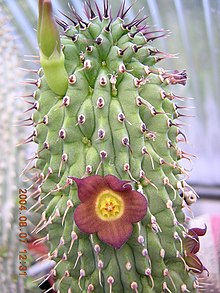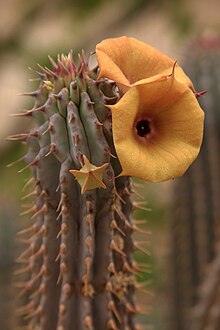Hoodia
| Hoodia | ||||||||||||
|---|---|---|---|---|---|---|---|---|---|---|---|---|

Hoodia gordonii on site in the Karoo |
||||||||||||
| Systematics | ||||||||||||
|
||||||||||||
| Scientific name | ||||||||||||
| Hoodia | ||||||||||||
| Sweet ex Decne. |
The genus Hoodia ( Syn .: Trichocaulon N.E.Br. ) belongs to the subfamily of the silk plants (Asclepiadoideae) in the family of the dog poison plants (Apocynaceae). The species of the genera, like species of many genera of the Untertribus Stapeliinae, belong to those that are called carrion flowers in German . Some species are used medicinally (see Hoodia gordonii ). The genus is named after the British doctor and succulent collector William Chamberlain Hood (1790–1879).
description

The plants are succulent and look very similar in habit to some cacti or succulent Euphorbia . The stems are low or rarely over 60 cm high and always bare. They are branched from the base with many-ribbed, thick stems, the leaf cushions of which end in a sharp thorn tip.
The five-fold flowers of most species are very large. The five sepals are fused and end with five pointed tips. The five petals are fused at the base to form a flat or bowl-shaped, recessed crown and are mostly reddish in color. There are fruit capsules formed.
Occurrence
The distribution area extends from the southern Cape Province over Namibia to Angola and Botswana , so it is floral elements of the Capensis . They colonize dry and low-precipitation ( arid ) areas, stony and sandy-loamy semi-deserts . There are areas with both summer and winter rain. The centers of biodiversity are Namibia (with eleven species) and South Africa (with nine species).
Types (selection)
There are around 13 (up to 20) types of Hoodia :
- Hoodia alstonii (NEBr.) Plowes (Syn .: Trichocaulon alstonii N.E.Br. ): It occurs from southern and southwestern Namibia to the North Cape.
-
Hoodia currorii (Hook.) Decne. : With two subspecies:
- Hoodia currorii subsp. currorii (Syn .: Hoodia macrantha Dinter , Hoodia gibbosa Nel ): It occurs from southwestern Angola to Namibia.
- Hoodia currorii subsp. lugardii (NEBr.) Bruyns (Syn .: Hoodia lugardii N.E.Br. ): It occurs from Botswana to Limpopo .
- Hoodia dregei N.E.Br. : It occurs in the western capensis.
- Hoodia flava (NEBr.) Plowes (Syn .: Trichocaulon flavum N.E.Br. ): It occurs from southern Namibia to western Capensis.
- Hoodia gordonii (Masson) Sweet ex Decne. (Syn .: Stapelia gordonii Masson , Hoodia barklyi Dyer , Hoodia burkei N.E.Br. , Hoodia longispina Plowes ): It occurs from Namibia to the Free State .
- Hoodia juttae Dinter : It occurs in southern Namibia.
- Hoodia mossamedensis (LCLeach) Plowes (Syn .: Trichocaulon mossamedensis L.C.Leach ): It occurs in the southwestern Angola.
-
Hoodia officinalis (NEBr.) Plowes : With two subspecies:
- Hoodia officinalis subsp. delaetiana (Dinter) Bruyns (Syn .: Hoodia delaetiana (Dinter) Plowes ): It occurs in southwestern Namibia.
- Hoodia officinalis subsp. officinalis : It occurs from the south-central and southern Namibia to the Free State .
- Hoodia parviflora N.E.Br. : It occurs from southwestern Angola to northwestern Namibia.
- Hoodia pedicellata (Schinz) Plowes (Syn .: Trichocaulon pedicellatum Schinz ): It occurs from southwestern Angola to northwestern and west-central Namibia.
-
Hoodia pilifera (Lf) Plowes : With the subspecies:
- Hoodia pilifera subsp. annulata (NEBr.) Bruyns (Syn .: Hoodia annulata (NEBr.) Plowes ): It occurs in the Capensis.
- Hoodia pilifera subsp. pilifera : It occurs in the Capensis.
- Hoodia pilifera subsp. pillansii (NEBr.) Bruyns (Syn .: Hoodia grandis (NEBr.) Plowes , Hoodia coleorum Plowes , Hoodia pillansii N.E.Br. , Trichocaulon pillansii N.E.Br. ): It occurs in the western Capensis.
- Hoodia ruschii Dinter : It occurs in Namibia.
- Hoodia triebneri (Nel) Bruyns (Syn .: Hoodia foetida Plowes , Trichocaulon triebneri Nel ): It occurs in central Namibia.
Species protection
The genus Hoodia was placed under international species protection in 2004 (13th Conference of the Parties to the Washington Convention on the Protection of Species). Whole plants as well as parts and products from them (e.g. pharmaceutical products / food supplements) may only be traded if a nature-friendly origin can be proven. Violations of the existing export or import permit requirement can result in fines and even criminal proceedings. Even in intra-European trade, both the seller and the buyer must be able to prove that the product or the processed plant has reached the EU with the stated permits. This also applies to purchases via the Internet, especially if the shipment comes from a non-EU country.
swell
- Information about the genus. at plantzafrica.com (English)
- Dangerous slimming products: Hoodia: Danger to health and environment
Individual evidence
- ↑ Lotte Burkhardt: Directory of eponymous plant names . Extended Edition. Botanic Garden and Botanical Museum Berlin, Free University Berlin Berlin 2018. [1]
- ^ Hoodia on the Germplasm Resources Information Network (GRIN), USDA , ARS , National Genetic Resources Program. National Germplasm Resources Laboratory, Beltsville, Maryland.
- ↑ a b c d e f g h i j k l m n o p q Rafaël Govaerts (Ed.): Hoodia - World Checklist of Selected Plant Families of the Royal Botanic Gardens, Kew. Last accessed on November 8, 2017.
- ↑ Regulations for the trade in protected species - Homepage of the Federal Agency for Nature Conservation.
- ↑ Regulation (EC) No. 338/97 (EU species protection regulation) in the consolidated version of August 22, 2005 (PDF; 391 kB) ( Hoodia listed on p. 76).




